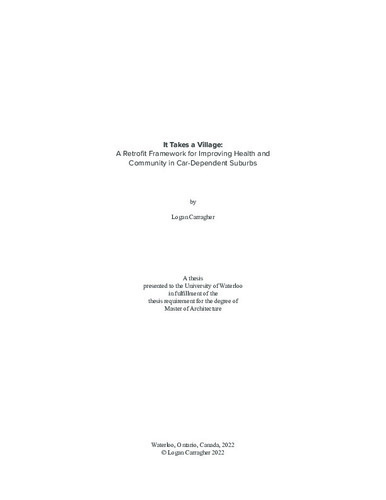| dc.description.abstract | Car-dependent suburban sprawl is an outdated planning methodology that is antithetical to the health, wellbeing, and social prosperity of suburban residents. In the past, North-American town planning was more community-centric; however, after World War II, suburbanization took it in a markedly different direction. Suburbs provide less expensive housing than in cities, quieter neighbourhoods, and are ideal for nuclear families. These benefits, however, do not outweigh the health, social, and environmental concerns associated with them. The car-dependency of suburbs causes a plethora of health ailments and results in obesogenic neighbourhoods, as well as reduces residents’ overall satisfaction with life. Socially, suburbs promote group separation which decreases civic engagement, and they consume valuable time due to the commuting necessity, eroding the social identity of the region. Lastly, the extensive amount of space they take up eats into wilderness and farmland, and the carbon emissions per-capita are much higher than in cities.
As a product of the Covid-19 pandemic, work-from-home culture has become widely accepted out of necessity, causing suburbanites to spend more time in suburbs throughout the day. It has also initiated a migration of city dwellers moving to the urban periphery who are taking advantage of distanced work culture and lower housing prices. As such, it is more important than ever for architects and planners to re-examine the composition of suburban neighbourhoods in order to provide a better quality of life to residents. This thesis explores the use of a retrofit framework to supplement single-family home neighbourhoods to better support more time spent there. It invents the concept of villageness and argues that this is what is missing from suburbs. Neighbourhood identity, social gathering spaces, ease of pedestrian transit, and resource availability are proposed categories that can be combined to produce villageness. Through this framework and the villageness it creates, existing suburbs have the potential to become healthier, self-supporting communities that are less heavily reliant on the automobile to function. | en |

